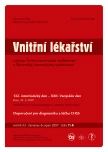Mineral-bone disorder with chronic kidney disease
Authors:
D. Sobotová; A. Zharfbin; M. Neobálková; J. Svojanovský; M. Souček
Authors‘ workplace:
II. interní klinika Lékařské fakulty MU a FN u sv. Anny Brno, přednosta doc. MUDr. Miroslav Souček, CSc.
Published in:
Vnitř Lék 2007; 53(7-8): 841-851
Category:
Overview
Mineral-bone disorder in chronic kidney disease is a clinical syndrome provoked by the combination of three factors: abnormal laboratory results, bone morphology disorder and extra-bone calcification. Its onset in adult age is linked with a decrease in glomerular filtration (GF < 1 ml/s). Fully developed forms occur in the course of regular dialysis treatment. The use of the traditional denomination „renal osteodystrophy“ is currently restricted to the bone morphology finding. As there are two threshold types of bone turnover (low and high) and two degrees of mineralisation (low and normal), there is a total of four basic variants of mineral-bone disorder. The high turnover variants – secondary hyperparathyreosis and a combined disorder – are still the most frequent and are diagnosed in 70 to 80 % of cases. Low turnover disorders include osteomalatia (OM) and adynamic bone disease (ABD). While OM is becoming increasingly rare, the occurrence of ABD is on the rise. The main reason for this may be the steady growth in the age of dialised patients and a number of risk factors, as well as treatment with inadequately high doses of vitamin D. Progressive chronic kidney disease may be linked with D-hormone deficit, negative calcium balance and with positive phosphate balance. Phosphates become a key factor in the development and progression of secondary hyperparathyreosis and extra-bone calcification in the case of D-hormone substitution. Therefore, maintaining a good phosphate balance by restricting their intake or by reducing their intestinal resorption through the use of phosphate binders is the most efficient therapeutic procedure. In patients with chronic kidney failure, adequate dialysis treatment is necessary. Hyperphosphatemia and extra-bone calcification are new independent risk factors of cardiovascular morbidity and mortality.
Key words:
renal osteodystrophy – chronic kidney disease – biochemical markers – secondary hyperparathyreosis – extra-bone calcification
Sources
1. Block GA, Spiegel DM, Ehrlich J et al. Effects of sevelamer and calcium on coronary artery calcification in patients new to hemodialysis. Kidney Int 2005; 68: 1815-1824.
2. Braun J. Extraosseous calcification in patiens with chronic renal failure - no escape? Nephrol Dial Transplant 2005; 20: 2054-2059.
3. Braun AJ, Dusso AS, Slatopolsky E. Vitamin D analogues for secondary hyperparathyreoididism. Nephrol Dial Transplant 2002; 17 (Suppl 10): 10-19.
4. Cannata-Andia JB, Rodriguez-Garcia M. Hyperphosphatemia as a cardiovascular risk factor - how to manage the problem? Nephrol Dial Transplant 2002; 17 (Suppl 11): 16-19.
5. Cannata-Andia JB Pathogenesis, prevention and management of low-bone turnover. Nephrol Dial Transplant 2006; 15 (Suppl 5): 15-17.
6. Ferreira A Biochemical markers of bone turnover in the diagnosis of renal osteodystrophy: What do we have, what do we need? Nephol Dial Transplant 1998; 13 (Suppl 3): 29-32.
7. Ferreira A, Urena P, Ang KS et al. Relationship between serum β2mikroglobulin, bone histology, and dialysis membranes in uremic patients. Nephrol Dial Transplant 1995; 10: 1701-1707.
8. Floege J, Ketteler M. Vascular calcification in patients with end-stage renal disease. Nephrol Dial Transplant 2004; 19 (Suppl 5): 59-66.
9. Gal-Moscovici A, Popovtzer MM. Parathyreoid hormone-independent osteoclastic resorptive bone disease: a new variant of adynamic bone disease in haemodialysis patients. Nephrol Dial Transplant 2002; 17: 620-624.
10. Ketteler M, Floege J. Calcification and the usual suspect phosphate: still guilty but there are other guys behind the scenes. Nephrol Dial Transplant 2006; 21: 33-35.
11. London GM, Guerin AP, Marchais SJ et al. Arterial media calcification in end-stage renal disease: impact on all-cause and cardiovascular mortality. Nephrol Dial Transplant 2003; 18: 1731-1740.
12. Malluche HH. Aluminium and bone disease in chronic renal failure. Nephrol Dial Transplant 2002; 17 (Suppl 2): 21-24
13. Moe S, Drüeke T, Cunningham J et al. Definition, evaluation, and classification of renal osteodystrophy: A position statement from Kidney Disease: Improving Global Outcomes (KDIGO). Kidney Int 2006; 69: 1945-1953.
14. Persy VP, Behets GJ, Bervoets AR et al. Lanthanum: A safe phosphate binder. Seminars in Dialysis 2006; 19: 195-199.
15. Rodriguez M, Nemeth E, Martin D. The calcium-sensing receptor: a key factor in the pathogenesis of secondary hyperparathyreoidism. Am J Physiol Renal Physiol 2005; 288: F253-F264.
16. Shahapuni I, Mansour J, Harbouche L et al. How do calcimimetics fit into the management of parathyroid hormone, calcium, and phosphate disturbances in dialysis patients? Seminars in Dialysis 2005; 18: 226-238.
17. Shanaham CM. Vascular calcification - a matter of damage limitation. Nephrol Dial Transplant 2006; 21: 1166-1169.
18. Sigrist M, Bungay P, Taal MT et al. Vascular calcification and cardiovascular function in chronic kidney disease. Nephrol Dial Transplant 2006; 21: 707-714.
19. Silver J. Molecular mechanism of secundary hyperparathyreoidism. Nephrol Dial Transplant 2000; 15 (Suppl 5): 2-7.
20. Slatopolsky E. The role of calcium, phosphorus and vitamin D metabolism in the development of secondary hyperparathyreoidism. Nephrol Dial Transplant 1998; 13 (Suppl 3): 3-8.
21. Tokumoto M, Tsuruya K, Fukuda K et al. Parathyroid cell growth in patients with advanced secondary hyperparathyroidism: vitamin D receptor and cyclin-dependent kinase inhibitors, p21 and p27. Nephrol Dial Transplant 2003; 18 (Suppl 3): 9-12.
22. Westenfeld R, Ketteler M, Brandenburg VM. Anti-RANKL therapy - implications for the bone-vascular-axis in CKD? Denosumab in post-menopausal women with low bone mineral density. Nephrol Dial Transplant 2006; 21: 2075-2077.
23. National Kidney Foundation. K/DOQI clinical praktice guidelines for bone metabolism and disease in chronic kidney disease. Am J Kidney Dis 2003; 42 (Suppl 3).
Labels
Diabetology Endocrinology Internal medicineArticle was published in
Internal Medicine

2007 Issue 7-8
Most read in this issue
- Hypopituitarism – substitution therapy
- Autoimmune polyglandular syndromes: clinical aspects
- Aspiration cytology of the thyroid
- Randomly discovered enlargement in the region of sella turcica
